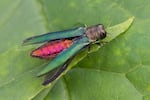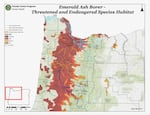It’s taken 20 years, but the most destructive insect in the country has been found in Oregon: the emerald ash borer.

Altenhoff said there are a fair number of ash trees in city parking lots and parks.
Courtesy of Oregon Department of Forestry
The metallic green beetle first showed up in Detroit, Michigan in 2002, likely in pallet material from Asia. It was found in Oregon last month in Forest Grove, the first West Coast sighting. Emerald ash borers kill most ash trees within 10 years of arrival, and they’ve caused billions of dollars of economic damage.
Scott Altenhoff is with the Oregon Department of Forestry. He told KLCC, “Early detection is going to be key, so if folks have ash trees, or suspect they have ash trees, if folks can familiarize themselves with the basic signs and symptoms of emerald ash borer and then call in early, that will help us.”
Altenhoff said to look for dieback starting at the top of the tree. Woodpeckers are also a sign of infection. He said woodland and wetland areas in the Willamette Valley are the epicenter for the Oregon ash tree, and will be a focus of the state’s efforts.
He says the City of Eugene is ahead of the curve. Local parks staff have mapped out vulnerable areas and put together a response plan. They may remove trees if it makes sense, and will follow the best practices learned from other communities.

Ash trees are vital to keeping streams and rivers shaded, and healthy for fish and other species. The map shows areas most likely to be impacted by the Emerald Ash Borer.
Courtesy of Oregon Department Of Forestry
Eugene was part of an effort to gather ash seeds. About a million ash tree seeds have been gathered and are being stored. In a worst-case scenario, once the beetles have run through existing trees, the state could replant with ash trees that are more genetically resistant to the insects.
To report sightings of the emerald ash borer, please make a report online at the Oregon Invasive Species Council hotline. For more information about the impacts of EAB on Oregon’s urban forests and the risks to native ash trees please visit ODF’s Forest Health page. The state of Oregon has a response plan in place. You can find it here.